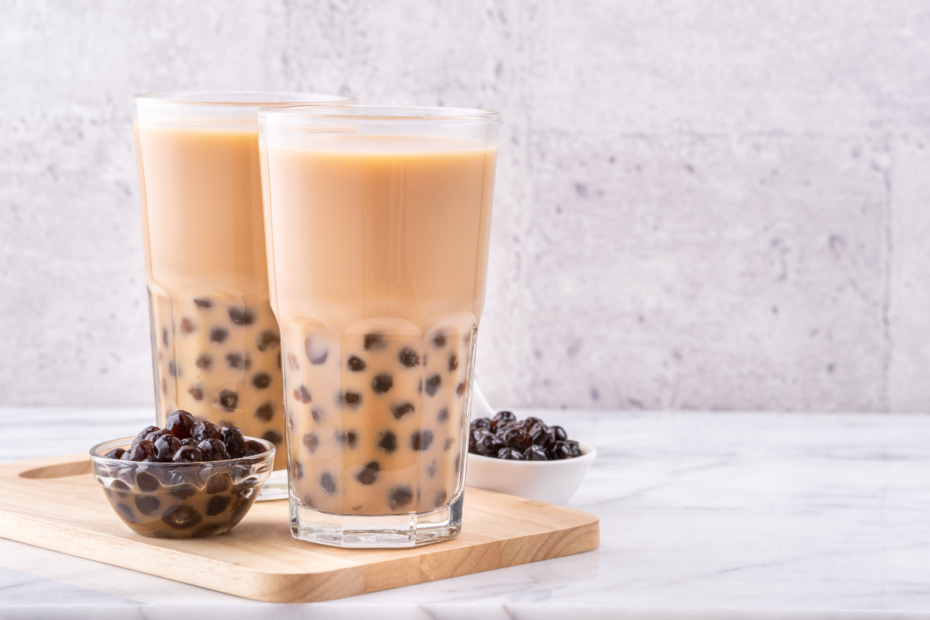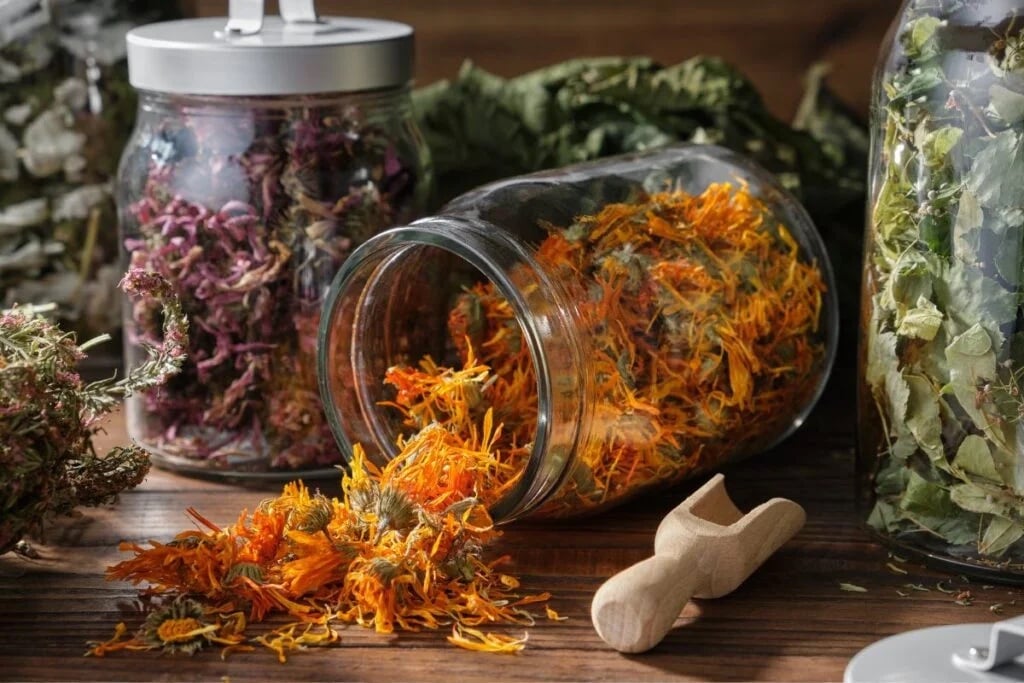Bubble tea, also known as tapioca pearl tea, is a tea-based beverage that originated in Taiwan in the early 1970s. Bubble tea is usually made with chewed tapioca balls (‘pearls’); most of the pearls are black and made of brown sugar. Tapioca is a starch synthesized from the roots of the cassava plant, scientifically known as Manihot esculenta. It is often processed into tiny bubbles that look like pearls, which make bubble tea benefits.
Tapioca pearls are made by finely grinding the roots of the Manihot to extract the starchy liquid. The water it contains is then evaporated to produce a fine white powder. This powder undergoes a manufacturing process, including high-pressure sieving, to obtain bright white, translucent spheres resembling pearls.
Types of Bubble Tea
Bubble teas fall into two categories: non-milk teas and milk teas. Both types are based on black, green, or oolong tea. Milk teas are usually made with powdered or fresh milk, but condensed milk or plant milk (almond, soya, oat, or coconut) may also be used. Other variations of bubble tea are also available.
- Hong Kong bubble tea is made from black tea, coffee, and milk.
- Bubble teas are cocktails where tea is mixed with ice cream and fruit.
The mixture of hot Taiwanese black tea, condensed milk, tapioca pearls, and syrup or honey is a version of the earliest known bubble tea. Nowadays, people usually serve bubble tea cold.
The popularity of bubble tea has also led to the invention of bubble tea-flavored snacks: bubble tea ice cream, smoothies, and sweets. The increased demand for bubble tea opens up production opportunities and market development in this industry.
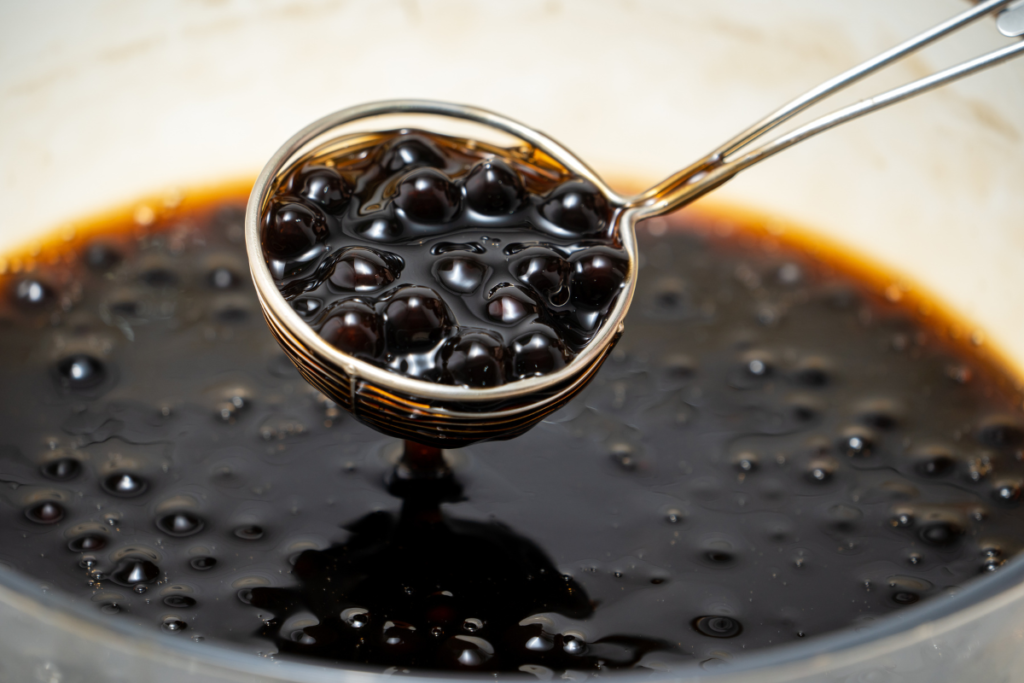
Health Benefits of Tapioca Pearls
Today, tapioca pearls are used worldwide, both in dishes and in teas. Compared to high-fiber cereals (wheat, oats, etc.), they are low in nutrients and advantageous in low-sodium and cholesterol diets. Although they are low in sodium and almost without cholesterol, they are rich in calcium, which strengthens bones; iron, which is essential for the synthesis and transport of blood; manganese, which ensures optimal metabolism; and folic acid, which is essential for the synthesis of DNA and the proper division of cells in all body tissues. Tapioca pearls prevent the risk of certain chronic diseases, such as muscular atrophy, promote metabolism, and improve general well-being.
- Tapioca pearls are a beneficial food for the underweight and those trying to gain weight. It is rich in simple carbohydrates and starch, which help to form essential fatty tissues, protect internal organs, and ensure an even distribution of lipids throughout the body. Eating a couple of bowls of tapioca pearls increases the chances of weight gain. At the same time, there is no increase in the risk of consuming too much fat and cholesterol.
- Tapioca flour is free of gluten, nuts, and grains, so it will not cause reactions in people with coeliac disease, gluten sensitivity, or nut allergies. You can use tapioca flour at home in baked goods to avoid allergens. It replaces white flour to thicken soups, sauces, and cake fillings. Suitable for vegetarians.
- Tapioca pearls can stimulate muscle growth as they are rich in essential amino acids and proteins. These are essential for many enzymatic reactions in the body’s cells and tissues to maintain the proper functioning of all organs. Tapioca pearls can also increase muscle mass and improve the tensile strength of connective tissues, which promotes muscle development.
- The stomach rapidly absorbs the regular sugars and starch in tapioca pearls (easier than any other flour made from cereals or nuts). They also help to unclog the intestines, thus preventing constipation and irritable bowel syndrome.
- Tapioca pearls are rich in folic acid, and pregnant women can use them. Folic acid is essential for fetal development and helps prevent birth deformities. Folate also promotes the synthesis of red blood cells, which helps carry nutrients to vital organs of the body.
- It is the perfect food for a quick energy boost when fatigued.
- Tapioca pearls are rich in calcium, vital for bones and teeth, blood vessels, the nervous system, blood clotting, etc. 100 g of tapioca pearls contain 20 mg of calcium.
- For those who want to consume less salt or sodium, tapioca pearls are the right choice. High levels of sodium in food relate to high blood pressure, heart disease, and stroke.
- A source of iron, it is also suitable for use during pregnancy when the need for iron increases. Use bubble teas with fruit containing vitamin C to maximize iron absorption.
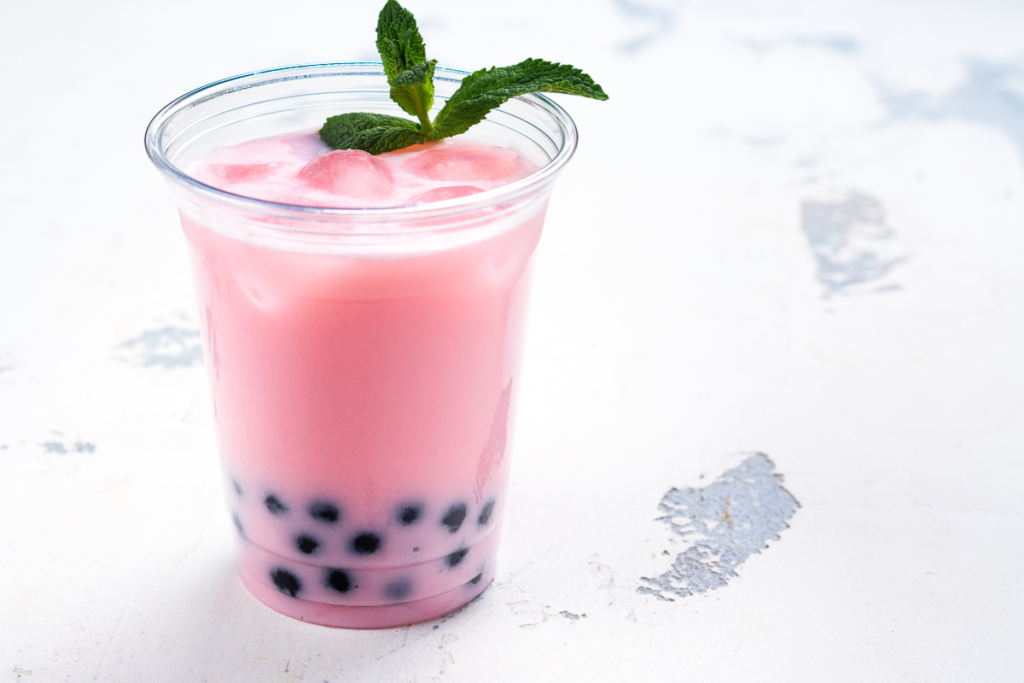
How to Prepare Bubble Tea with Brown Sugar Syrup
To make tapioca pearl tea with brown sugar, you will need:
- 200 g tapioca pearls;
- Water;
- Brown sugar syrup (or 50 g of regular sugar);
- Your favorite prepared tea.
Preparation:
- Bring 1 liter of water to a boil in a saucepan, then add 200 g of tapioca pearls. If you boil a smaller quantity of pearls, reduce the water proportionally.
- Once boiling, reduce the heat and simmer for 20 minutes, then leave it in the pot for another 10 minutes.
- Rinse the tapioca pearls in cold water afterward.
- Let’s prepare the brown sugar syrup. Add 60 ml of water and 50 g of brown sugar to a pan. When it has dissolved, boil for 2–3 minutes.
- Pour the syrup over the cooled pearls and stir. You can also sweeten it with plain sugar, but the brown sugar syrup will give it a deeper flavor.
- Place the prepared tapioca pearls in a cup and pour over your favorite tea.
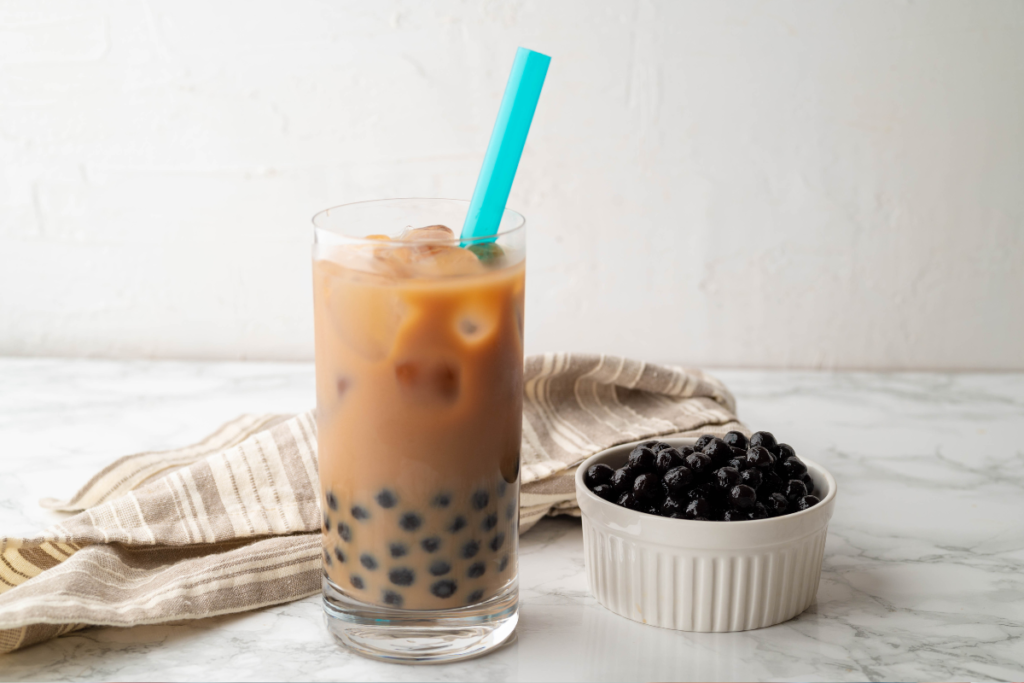
Black Tapioca Tea with Milk
To make one of Taiwan’s favorite teas, you will need:
- 2 tea bags or 2 g of black tea,
- 50 g of quick-cooking tapioca balls (look for those that boil in 5 minutes),
- 1 teaspoon dark brown sugar,
- ice cubes,
- 200 ml of milk (or plant milk),
- 50 g of dark brown sugar (for syrup),
- water.
Directions:
- Add 100 ml of water to a saucepan or teapot and bring to a boil. Then add the black tea bags or tea leaves and leave for 10–15 minutes. Remove the tea bags or strain the tea to remove the leaves, and leave to cool.
- Bring 500 ml of water to a boil in a saucepan, add the tapioca balls, and reduce the heat to a simmer, stirring to prevent the balls from sticking to the side of the saucepan. Cook for 5 minutes and leave to stand for another 5 minutes.
- Afterward, put the pearls in a sieve and rinse them gently with cool water. Stir gently with a spatula to prevent the pearls from sticking to the walls and to ensure they cool evenly.
- When the tapioca pearls have cooled, place them in a bowl, add 1 teaspoon of dark brown sugar, and mix thoroughly.
- Make the syrup: add 50 g of brown sugar and 60 ml of water to a pan, stir slowly, and bring to a boil. When all the sugar has dissolved, remove it from the stove and leave it to cool. The syrup will thicken once it has cooled. You will get about 80 ml of syrup or approximately 2.5 portions. You can store leftover syrup in a jar in the fridge for up to a month.
- Mix the prepared tapioca pearls with the brown sugar syrup and toast them in a pan for a savory taste. (Store the prepared pearls covered for up to 3 hours, but don’t put them in the fridge; they will harden.).
- Place the prepared sweet pearls in a large glass (485 ml) or two smaller glasses, pour in the prepared tea and 1 tablespoon of syrup, add half a glass of ice, and stir. Then add 200 ml of cold milk and serve with a special boba straw.
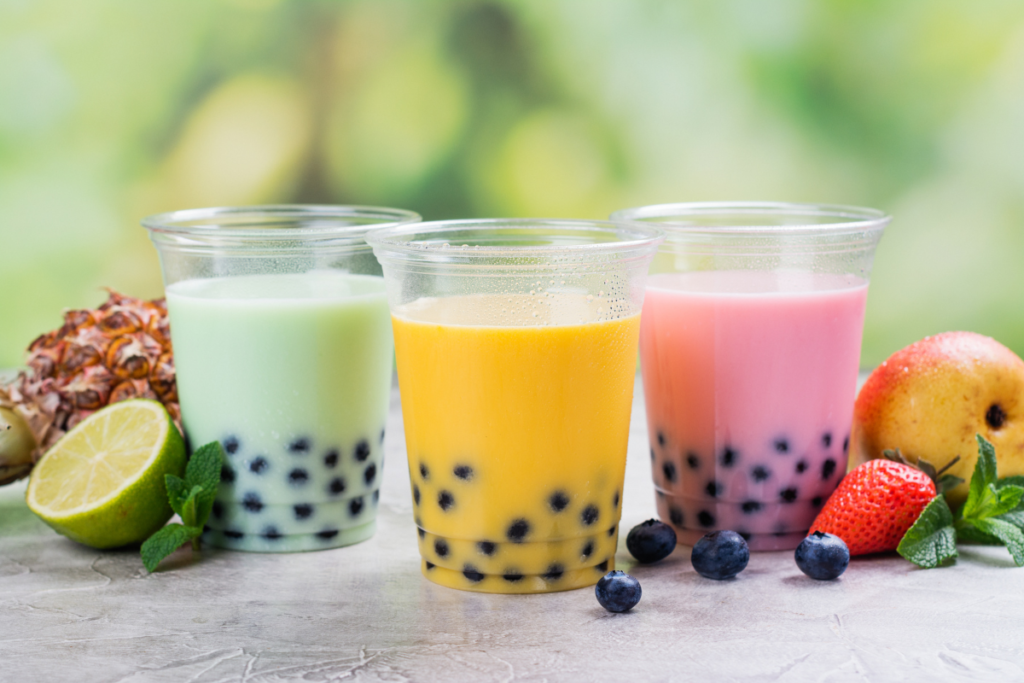
Side Effects of Bubble Tea and Tapioca Pearls
Tapioca can be an essential part of a healthy diet if eaten moderately. On the other hand, people should be aware of tapioca pudding and bubble tea because they contain extra calories and fat due to added sugar, milk, or cream. There is an option: you can use almond milk or low-fat milk. Replace sugar with stevia, agave, or maple syrup to make tapioca dishes sweeter.
As bubble tea has become very popular in Singapore, in July 2019, the Mount Alvernia Hospital in Singapore warned that bubble tea is high in sugar. While acknowledging the benefits of drinking green and black tea in reducing the risk of cardiovascular disease, diabetes, arthritis, and cancer, it warned that adding other additives to the tea, such as a milk substitute containing trans-fatty hydrogenated palm oil, increases the fat and sugar content of the tea. Palm oil increases the risk of heart disease and stroke.
Tapioca pearls are made entirely of starchy carbohydrates. It means, that people on a carbohydrate diet and those concerned about the effects of starch on blood sugar levels should avoid the tea.
Associative photos from © Canva.
